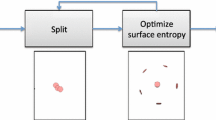Abstract
A fundamental problem when computing statistical shape models (SSMs) is the determination of correspondences between the instances. Often, homologies between points that represent the surfaces are assumed which might lead to imprecise mean shape and variation results. We present a novel algorithm based on the affine Expectation Maximization - Iterative Closest Point (EM-ICP) registration method. Exact correspondences are replaced by iteratively evolving correspondence probabilities which provide the basis for the computation of mean shape and variability model. We validated our approach by computing SSMs using inexact correspondences for kidney and putamen data. In ongoing work, we want to use our methods for automatic classification applications.
Access this chapter
Tax calculation will be finalised at checkout
Purchases are for personal use only
Preview
Unable to display preview. Download preview PDF.
Similar content being viewed by others
References
Lorenz C, Krahnstoever N. Generation of point-based 3D statistical shape models for anatomical objects. Computer Vision and Image Understanding 2000;77(2):175–191.
Raynaud N. Segmentation d’Images Hépatiques par Analyses Statistiques. Master’s thesis. DEA Mathématiques, Vision, Apprentissage — ENS Cachan; 2000.
Bookstein FL. Landmark methods for forms without landmarks: Morphometrics in group differences in outline shapes. Medical Image Analysis 1996;1:225–243.
Shelton CR. Morphable surface models. International Journal of Computer Vision 2000;38(1):75–91.
Besl PJ, McKay ND. A method for registration of 3D shapes. IEEE Trans Pat Anal and Mach Intel 1992; 239–256.
Davies RH, Twining CJ, Cootes TF. A minimum description length approach to statistical shape modeling. IEEE Transactions on Medical Imaging 2002;21(5).
Heimann T, Wolf I, Williams T, Meinzer HP. 3D active shape models using gradient descent optimization of description length. In: IPMI. vol. 3565; 2005. 566–577.
Zhao Z, Theo EK. A novel framework for automated 3D PDM construction using deformable models. Procs SPIE 2005;5747:303–314.
Rangarajan A, Chui H, Bookstein FL. The softassign procrustes matching algorithm. In: IPMI; 1997. 29–42.
Granger S, Pennec X. Multi-scale EM-ICP: A fast and robust approach for surface registration. LNCS 2002;2353:418–432.
Schroeder WJ, Zarge JA, Lorensen WE. Decimation of triangle meshes. Computer Graphics 1992;26(2):65–70.
Author information
Authors and Affiliations
Editor information
Editors and Affiliations
Rights and permissions
Copyright information
© 2007 Springer-Verlag Berlin Heidelberg
About this paper
Cite this paper
Hufnagel, H., Pennec, X., Ehrhardt, J., Handels, H., Ayache, N. (2007). Point-Based Statistical Shape Models with Probabilistic Correspondences and Affine EM-ICP. In: Horsch, A., Deserno, T.M., Handels, H., Meinzer, HP., Tolxdorff, T. (eds) Bildverarbeitung für die Medizin 2007. Informatik aktuell. Springer, Berlin, Heidelberg. https://doi.org/10.1007/978-3-540-71091-2_87
Download citation
DOI: https://doi.org/10.1007/978-3-540-71091-2_87
Publisher Name: Springer, Berlin, Heidelberg
Print ISBN: 978-3-540-71090-5
Online ISBN: 978-3-540-71091-2
eBook Packages: Computer Science and Engineering (German Language)




